Facts about Berlin

In 1740, the philosophically-oriented Friedrich II, known as Frederick the Great (1740-1786) came to power, and Berlin became a center of the Enlightenment.

Berlin is well known for the techno carnival Love Parade and the cultural festival Berliner Festspiele, which include the jazz festival JazzFest Berlin.
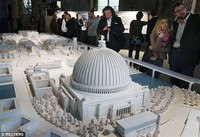
Hitler had planned to rebuild Berlin on a massive scale, renaming it "Welthauptstadt Germania"; but apart from the Olympic Stadium, the plan never progressed.
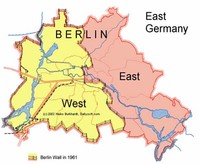
Berlin is located in eastern Germany, about 44 miles (70km) west of the border with Poland in an area with marshy terrain.

About 720 C.E., two Slavic tribes settled in the Berlin region—The Hevelli settled on the river Havel in Brandenburg, while the Sprevane settled close to the river Spree in today's district of Berlin-Kцpenick.

Berlin has been a center for national and international immigration since the Edict of Potsdam in 1685.

In 2006, the nominal GDP of Berlin experienced a growth rate of 1.5 percent (2.7 percent in Germany) and totaled Ђ80.3 ($104.4) billion.

East Germany proclaimed East Berlin (which it described only as "Berlin") as its capital, a move not recognized by the Western powers.

More than 15,000 Huguenots went to Brandenburg, of whom 6,000 settled in Berlin.

Berlin, the capital city of reunited Germany, is a young city by European standards, although it has had an impressive history since the ninth century, when "Berolina" was a small town on a trade route.
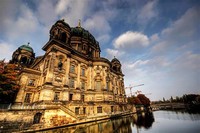
The localities often consist of a number of city neighborhoods (usually called Kiez in the Berlin dialect) representing small residential areas.
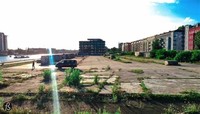
The industrial base of former East Berlin decreased dramatically within a decade, leading to an unemployment rate of almost 20 percent and stagnant GDP growth rates until 2005.

The Thirty Years' War, between 1618 and 1648, resulted in damage to one third of Berlin's houses, and the loss of half the city's population.

What was to become Berlin was well outside the frontiers of the Roman Empire, and was inhabited by Germanic tribes.

Some notable companies with their headquarters in Berlin are Axel Springer AG, Deutsche Bahn, Bombardier Transportation, Universal Music Germany and Vattenfall Europe.

Berlin is the capital city and one of the 16 states of the Federal Republic of Germany.

Public transport within Berlin is provided by the S-Bahn, which is a mostly overground urban railway system, and the U-Bahn, which is mainly underground.

The European Union invests in several projects within the city of Berlin.

In 1920, the Greater Berlin Act united dozens of suburban cities, villages, and estates into a greatly expanded city and established Berlin as a separate administrative region.

The city center lies along the river Spree in the Berlin-Warsaw Urstromtal (ancient river valley), formed by water flowing from melting ice sheets.
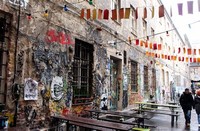
Berlin is home to more than 50 theaters, has three opera houses, and seven symphony orchestras, including the Berlin Philharmonic Orchestra.

Berlin's built-up area creates a microclimate, with heat stored by the city's buildings.

Research and development have gained significance, and Berlin now ranks among the top three innovative regions in the European Union.

After the reunification of Germany and Berlin in 1990, substantial subsidies were phased out, formerly received by the city of West Berlin.

In 1999, the German parliament and government began their work in Berlin.

Berlin’s service sectors have also benefited from improved transportation and communications links to the surrounding region.

After World War II, the city was divided; East Berlin became the capital of East Germany while West Berlin became a Western enclave, surrounded by the Berlin Wall from 1961-1989.

In 1451, Berlin became the royal residence, and had to give up its status as a free Hanseatic city.

Recognized for its festivals, contemporary architecture, nightlife and avant-garde arts, Berlin has evolved into a focal point for individuals attracted by liberal lifestyle, and modern zeitgeist ("spirit of the times").

The city suffered economically during the Cold War, when West Berlin was isolated geographically and East Berlin suffered from poor economic decisions made by East Germany’s socialist central planners.

Berlin was successively the capital of the Kingdom of Prussia (1701-1918), the German Empire (1871-1918), the Weimar Republic (1919-1933) and the Third Reich (1933-1945).

The three largest universities are the Freie Universitдt Berlin (Free University of Berlin) with around 35,000 students, the Humboldt Universitдt zu Berlin with 35,000 students, and the Technische Universitдt Berlin with 30,000 students.

The arrival of the federal government in 1999 brought some economic stimulus to Berlin.

Substantial parts of present-day Berlin extend onto the low plateaus on both sides of the Spree Valley.

Many buildings in the former city center of East Berlin became home to nightclubs, including Kunst Haus Tacheles, techno clubs Tresor, WMF, Ufo, E-Werk, the infamous Kitkatclub and Berghain.

Large parts of Berlin were destroyed in the 1943–1945 air raids and during the Battle of Berlin.

On October 3, 1990, the two parts of Germany were reunified as the Federal Republic of Germany, and Berlin became the German capital.

The suburb of Spandau is first mentioned in 1197, and Kцpenick in 1209, though these areas did not join Berlin until 1920.

Nazi rule destroyed Berlin's Jewish community, which numbered 170,000 before the Nazis came to power.

The Thirty Years' War, between 1618 and 1648, resulted in damage to one third of Berlin's houses, and the loss of half the city's population.

After the end of World War II in 1945, Berlin received large numbers of refugees from the Eastern provinces.

The victorious powers divided the city into four sectors—the United States, the United Kingdom, and France formed West Berlin, while the Soviet sector formed East Berlin.

Berlin, then with a population of around four million, was an exciting city known for a liberal subculture, including homosexuals and prostitution, and for its fierce political street fights.

In 1307, the two cities were united politically, and, over time, came to be known simply as Berlin, the name of the larger of the pair.
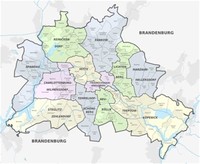
The boroughs of Berlin are not independent municipalities, and are subordinate to the Senate of Berlin.

After reunification in 1990, the industrial base of former East Berlin decreased, leading to high unemployment and stagnant GDP growth rates until 2005.

West Berlin remained a free city that was separate from the Federal Republic of Germany.

The borough of Spandau lies partly within the Berlin Urstromtal and partly on the Nauen Plain, which stretches to the west of Berlin.
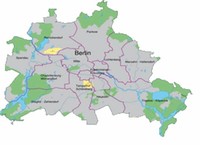
A series of lakes also feeds into the upper Spree, which flows through the GroЯer Mьggelsee in eastern Berlin.
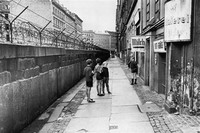
West Berlin became a de facto part of West Germany with a unique legal status, while East Berlin was de facto a part of East Germany.

The Industrial Revolution transformed Berlin during the nineteenth century; the city's economy and population expanded dramatically, and it became the main rail hub and economic center of Germany.

The name Berlin may derive from the old (West Slavic) Polabian stem berl- or birl- meaning "swamp."

In 1971, a Four-Power agreement guaranteed access across East Germany to West Berlin and ended the potential for harassment or closure of the routes.

Located in northeastern Germany, it is the center of the Berlin-Brandenburg metropolitan area, comprising 4.9 million people from over 180 nations.

Berlin is among the top five congress cities in the world and is home to Europe's biggest convention center in the form of the Internationales Congress Centrum (ICC).

The central part of Berlin can be traced back to two towns: Cцlln (on the Fisher Island) is first mentioned in a 1237 document, and Berlin in one from 1244.

Berlin has established itself as the third most visited city destination in the European Union.

The Linientreu is known for techno music, and the LaBelle discotheque in Friedenau was the location of the 1986 Berlin discotheque bombing.

Berlin was once a major manufacturing center and the economic and financial hub of Germany.

Berlin's unique recent history has left the city with an eclectic array of architecture and sights.
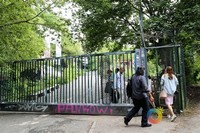
The highest elevations in Berlin are the Teufelsberg and the Mьggelberge, both of which have an elevation of about 377 feet (115 meters).

Following France's victory in the War of the Fourth Coalition, Napoleon Bonaparte marched into Berlin in 1806, but granted self-government to the city.








